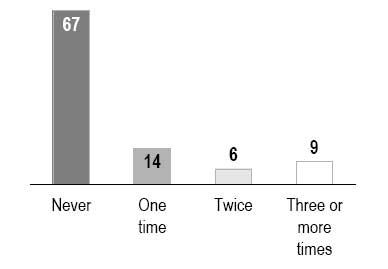Application of the New Voter Identification Procedures under Bill C-31 for the September 17 Federal By-elections in Quebec – Evaluation Synthesis
EFFECTS OF NEW ID REQUIREMENTS ON VOTING PROCESS
The third major element of the evaluation of the new identification requirements in place for the September 17, 2007 by-elections is the effects of the new requirements on the voting process. Did the new requirements slow down voting or otherwise adversely affect voter satisfaction with the voting process? This is a key element, as any change that significantly impacts satisfaction with the act of voting runs the risk of negatively impacting elector participation for future elections.
To ensure all viewpoints were considered in the evaluation of the impact of the new requirements on the voting process, the perspectives of both voters and elections officers were assessed.
Attitude Towards Voter ID Requirements
The vast majority of electors had a positive attitude towards the idea of voters having to prove their identity and only four percent of those who did not vote indicated that this was in any way connected to the new ID requirements.
Respondents to the survey of electors were asked how they felt about the idea of electors having to prove their identity in order to vote. More than nine in ten respondents said that their attitude towards the idea of electors having to prove their identity when voting at a federal election is positive, with two-thirds (68%) having a very positive attitude. Almost no one (2%) reported that their attitude towards the new identification procedures is “very negative”.
Respondents from Outremont, those with higher levels of education, and voters were most likely to report a “very positive” attitude. On the other hand, electors from Roberval, and those with lower education levels were the least likely to feel very positive about the new requirements.
Among those few respondents who had a negative attitude towards the new requirements, the most frequently mentioned reasons related to the “veiled women” cases for which ID documents cannot prove their identity (most often mentioned in Outremont and Saint-Hyacinthe), followed by the “uselessness of the requirements when everybody knows each other” (especially mentioned in Roberval).
Among those who reported they did not vote, only four percent indicated that their not voting was in any way related to the new identification requirements. It is important to note that this does not mean that the new requirements prevented these individuals from voting; they may not have voted even in the absence of new regulations.
A large majority of voters reported that the new ID requirements were easy to meet.
Virtually all of those who went to the polling station generally felt that meeting the new identification requirements was easy. More than nine in ten (95%) said it was at least somewhat easy to meet the new requirements, with seven in ten (71%) considering it very easy. There were no differences between districts in terms of the perceived ease of meeting the new identification requirements.
Ease of meeting new identification requirements
All districts combined 2007
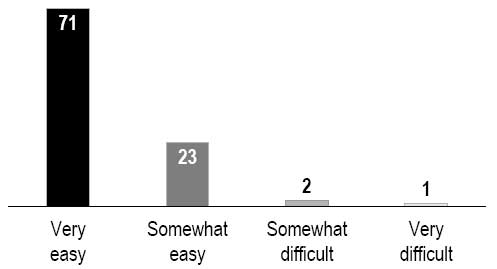
Voters' perspectives on impacts of new requirements on voting
More than eight in ten felt the new ID requirements did not adversely affect the time required to vote. Only three percent felt voting took a lot longer.
One important aspect of the voting process that has a direct impact on satisfaction with the process is the amount of time required to vote. As part of the evaluation of the new ID requirements, those who reported going to the polls were asked whether they felt that the new requirements affected the time taken to vote.
Overall, more than eight in ten (83%) did not feel that the time taken to vote was adversely affected by the new identification requirements. Only three percent felt that voting took a lot longer; the remainder felt that the impact on voting time was minor. Furthermore, the time of day when voting occurred did not have any relationship to perceptions of the impact of the new identification requirements on the time required to cast a ballot.
Impact of new requirements on time required to vote
All districts combined 2007
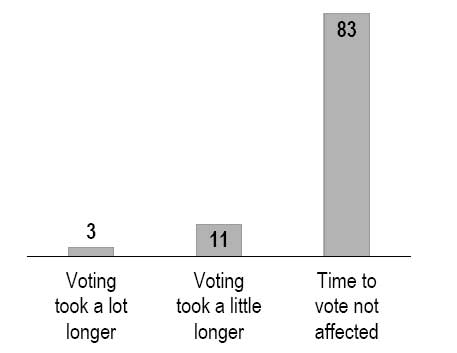
Only about one voter in twenty reported specific problems related to the new identification procedures.
Very few of those who went to the polling station reported encountering any difficulties that were related to the new identification requirements. Only six percent reported any such problems, with no one specific type of problem standing out. Reports of problems did not vary by district.
Election officers' perspectives on impacts of new requirements on voting
Almost all election officers felt the identification of voters generally went well and two-thirds did not encounter any specific problems. Lack of ID or proof of address were the most frequent problems encountered.
In terms of overall satisfaction, more than nine election officers in ten (94%) felt that the identification of voters during the vote went well, with almost two-thirds (64%) saying it went very well. In addition, three-quarters of election officers (74%) characterized voter reaction to the new requirements as “favourable”, with one in three (29%) saying it was “very favourable”.
Not surprisingly, election officers were more likely than were voters to report specific problems at the polls. As they were at the polls for extended periods, they had more opportunity to observe problems arise. Even so, more than two-thirds (68%) did not personally experience any specific problems. The most common problems reported were problems with proof of address (14%) and lack of valid ID (12%). Election officers working in Outremont were more likely to report problems.
Specific problems personally encountered
All election officers 2007
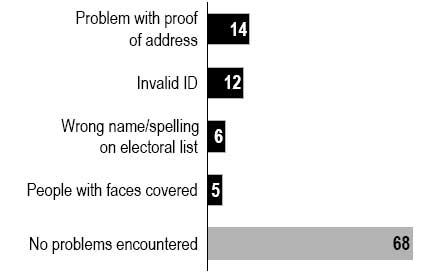
Most election officers reported having to deal with a voter annoyed by the new identification requirements at least once: more than half dealt with such voters “a few times”; however, only 9% had to deal with such voters often.
Frequency of dealing with voters annoyed by new requirements
All election officers 2007
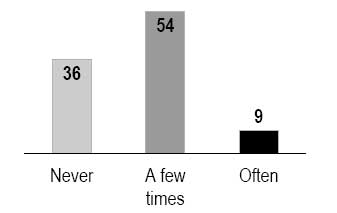
Just over one in ten (14%) ever had to consult the Returning Officer to resolve a specific problem related to the new identification requirements and only one percent had to do so “often.”
About four in ten election officers felt that voting took longer because of the new ID requirements, although few felt the impact was severe.
The experiences of election officers are a key component of the evaluation of the impact of the new identification requirements on the voting process. Overall, 41% had previous experience working at a poll, providing a reference point against which the new ID requirements could be assessed.
As with the voters, the opinions of election officers were sought regarding the impact of the new requirements on the time required for the voter to cast their ballot.
Election officers were somewhat more likely than were voters to feel that the new identification requirements slowed down the voting process. This is not surprising, as the election officers are at the polling station for a longer period and, therefore, have more of an opportunity to see problems that might delay the voting process for an individual voter. Overall, about four in ten (41%) of election officers felt that the voting process took at least a little longer than normal, although less than one in ten (7%) felt the process took a lot longer. Most of those who felt the voting process took longer believed that slowdowns took place only during peak periods; only 12 percent of election officers perceived that voting took longer throughout the day.
Impact of new identification requirements on time required to vote
All election officers 2007
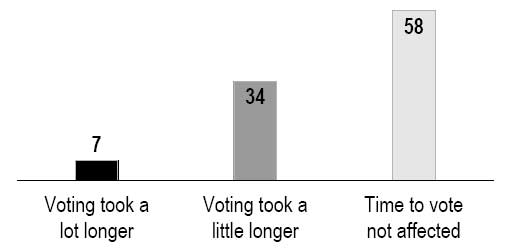
Most deputy returning officers reported that they saw voters attempting to use the VIC as ID on occasion, with one in five saying they saw it happen often.
It was noted earlier that about one-third voters reported that they at least considered using their VIC as a piece of identification and a small proportion of voters (about one in twenty) reported using (or attempting to use) the VIC in this way. Deputy returning officers were asked their perception of how frequently this happened as part of the assessment of problems during the voting process.
A majority of deputy returning officers reported that they observed voters trying to use the VIC as identification often (20%) or a few times (35%). Officers working in Outremont were more likely than other election officers to see voters attempt to use the VIC as identification.
Frequency of voter attempts to use VIC as identification
Deputy returning officers 2007
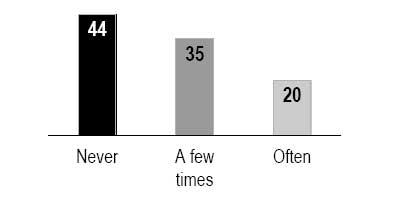
Two-thirds of deputy returning officers never had to refuse a ballot based on the new ID requirements. Overall, deputy returning officers refused an average of less than one ballot each for reasons related to the new identification requirements.
Deputy returning officers were also asked how often they had to refuse a ballot because the elector in question could not meet the identification requirements.
Two-thirds of the deputy returning officers reported that they never had to refuse a ballot for reasons related to the new identification requirements and only 15 percent had to do so more than once.
Frequency of refusing ballot due to identification problem
Deputy returning officers 2007
